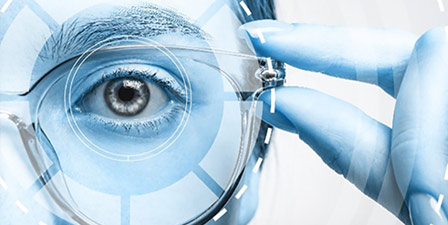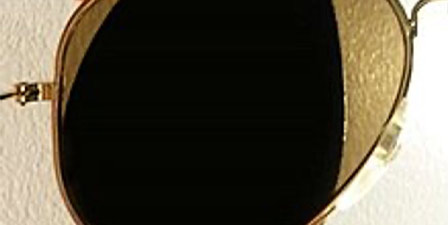
The Subtleties of Taking Heights and PDs Try on eyewear that has a minimum eye wire profile width of 1mm and fixate your eye on a line of text on a computer. (The distance from you to the computer screen is assumed to be approximately equal to the distance from your client when taking height measurements.) Try superimposing the top of your frame’s eye wire over a line of single-spaced text and then tilt your head up or down to just clear the eye wire above or below the text line. Note that the amount of head movement, up or down, required to clear the text line approximates 2mm at the vertex of most eyewear. Also note how minimally your head tilts during this test and use this awareness when verifying pupil height-related lens adaptation problems.
-
PDs Here is a measurement we often taken for granted. Notwithstanding
the improved precision and accuracy afforded by using a corneal-reflection
pupilometer in place of a PD ruler, ECPs should be aware of potential parallax related fitting errors. First, try taking three or four PDs in succession from one client. Now, prompt the client to help stabilize the measuring process by holding their end of the pupilometer as if they were “holding a binocular.” Repeat this measurement technique three to four times. Compare the results. You may be in for a few surprises, not only between your own measurements, but also between those taken with your client’s assistance. Additionally, try to retake a current PD every time you order new eyewear, even if the client is an adult. Even though we assume normal physiological growth has usually ceased by
age 25, there yet awaits some surprises about the “distance between the eyes”
for those who value the accuracy of their measurement process.
- Fabrication and Human Errors Let’s face it, checking eyewear orders for accuracy can seem an unrewarding consumption of a scarce
commodity—your time. Lens adaptation
problems arising from failure to perform due
diligence regarding order compliance poses the greatest potential for embarrassment: when you try to explain how errors occurred after the fact to your client. Whether mistakes crop up from the written prescription, your own office work order or order you sent to the lab, it is always easier to accept what’s been written than taking the time and trouble to check if the information actually is complete or makes sense. For instance, dispensers should check and confirm if an Rx change corresponds with the client’s vision
complaint or expectation. ECPs should be
particularly on guard about the ease with
which “twos and sevens” and “fives and
twos” can be confused or illegibly written.
Finally, there are the errors that often occur in rush-jobs, where the need to “get it out” trumps the need to “get it right.” When addressing these situations, the time we neglected to spend ensuring proper fabrication initially is now due.
- The Psychology of Optics Similar to the anticipation of a musical composition’s final cadence, our sense of vision more keenly anticipates and seeks to obtain the sharpest contrast from a retinal image. As a perfect focus is approached, it is not uncommon to find clients with a previous pair that was 0.75D weak, scratched and misaligned, to be especially fussy about just how well they see with their newly updated, unscratched and well-fitted new eyewear. It is interesting to see some people who don’t complain about wearing an older, out of date, 20/50 correction, seem particularly sensitive to their new eyewear not yielding a full 20/20. The closer patients get to optimal retinal contrast, whether from a careful refraction or clean, unscratched and newly AR-ed lenses, the more they’ll notice small deviations in perfect sharpness. There is an adaptation phenomenon that I call “one more bite.” Who hasn’t enjoyed a large meal and subsequently feels uncomfortably bloated from taking a small bite of dessert? In most cases,the size of the actual bite is small. The stomach upset that followed seems out of proportion to the extra amount eaten. Eyewear prescriptions can have a similar effect. We often puzzle how a change of just 0.25D can make some patients feel significantly nauseated. But if said small change mimics the “one more bite” phenomenon, it can produce uncomfortable effects for some people that are inconsistent with the amount of Rx change. ECPs should be sensitive to these types of vision-overload symptoms.













